After having done a fairly thorough job of lambasting The Charge of the Light Brigade for depicting India idiotically, I decided I had to show that I’m unbiased. If Hollywood could make a mess when it came to foreigners and foreign settings, Hindi cinema could surpass it. And how!
Dr Kotnis ki Amar Kahani is based on the real-life story of Dr Dwarkanath S Kotnis, who went to China in 1938 as part of a medical mission and did exemplary work in China. This, on its own, would be too insipid for the average Hindi film. But the fact that Kotnis married a Chinese girl while he was treating the ailing masses—well, that gives this story plenty of potential, and V Shantaram, director and lead actor of this film, milks it to the melodramatic full.
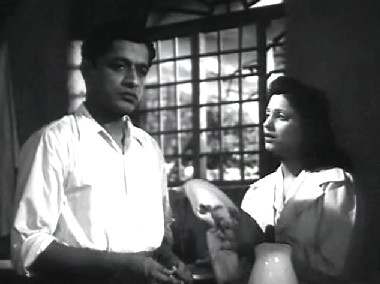
Dwarkanath Kotnis (V Shantaram) has come home to Sholapur after completing his medical studies in Bombay. His father (Keshavrao Date) and mother (Protima Devi; when did she first begin acting the mother? I don’t remember seeing her as anything but a longsuffering ma) are delighted to have Dwarka home.
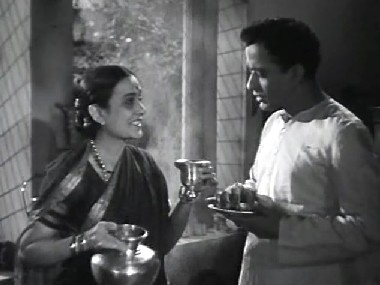
Dwarka’s father, in fact, has a surprise up his sleeve. A clinic, with Dwarka’s name on the nameplate and polished new equipment inside, is waiting for Dwarka to set up practice. Dwarka, however, says that he’s decided to go to China. This is 1938, and Japan’s been wreaking havoc in China. In Bombay the previous evening, Dwarka has heard a political leader encouraging the masses to help China’s wounded and needy with materials, medicines—and expertise. Doctors are needed urgently, and Dwarka has pledged to go.
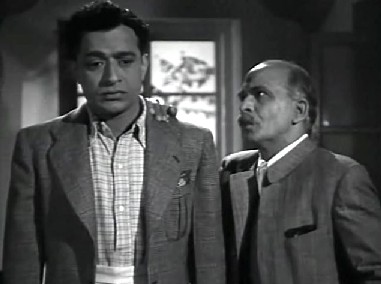
Though broken-hearted, Dwarka’s parents let him go. At the dock in Bombay, Dwarka introduces them to the four other doctors who’ll be going with him: Drs Atal, Cholkar, Basu and Mukherjee. His parents have a going-away present for Dwarka, something that’ll remind him always of where his loyalties lie.
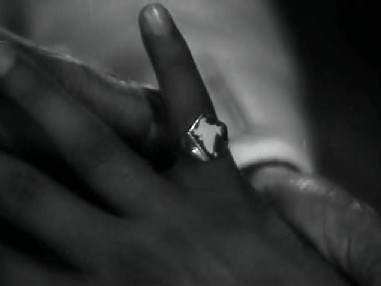
[Aside: I love the oldness of this film: it’s old enough to be from a time when India included present-day Pakistan and Bangladesh! And of course, it’s old enough to be a proponent of Hindi-Chini bhai-bhai, long before 1962 happened.]
The five Indian doctors arrive at Chungking, where they languish for the next four months, missing home and not called upon to do much in the way of saving lives. One evening, though, the Japs start bombing the town and Dwarka goes off to help get the wounded out from under the debris. In the process, he meets an old man called Wong (Dewan Sharar). An instant friendship springs up between the two and when Wong tells Dwarka he’s spent ten years in India, Dwarka dubs him Kaka (`Uncle’) Wong.
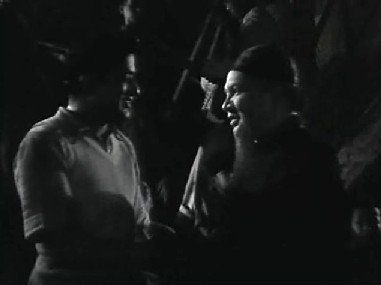
The doctors, after all this time, receive a bunch of long overdue mail from India. In a letter from home, Dwarka learns that his father has died. Urged on by his colleagues, he decides to return to India—and then changes his mind. No; his father and his mother had given him their blessings and they’d not have wanted him to come away without completing his mission.
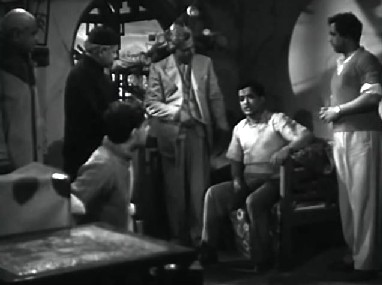
And the mission does get under way. The doctors, all now wearing uniforms (? Don’t ask me what), have to go to Yanan. They’re told they’ll be escorted by a young man called Ah Ching (Jaishree), who has some knowledge of medicine.
These guys may be doctors, but they’ve either got terrible eyesight, or their knowledge of human anatomy is absymal. Ah Ching (an irritating character who seems to know only two phrases: “Nahin sahib” and “Haan sahib”) is so obviously female.
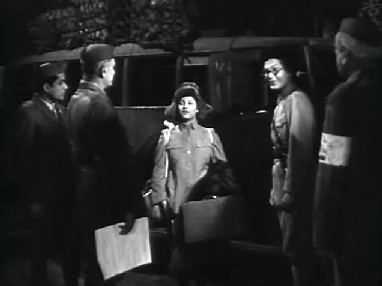
At Yanan (conveniently signposted in Hindi as well as Chinese: this, by the way, seems pretty universal), it’s very cold. The doctors arrive in a van that has an attractive and patently artificial icing-like trim of snow:
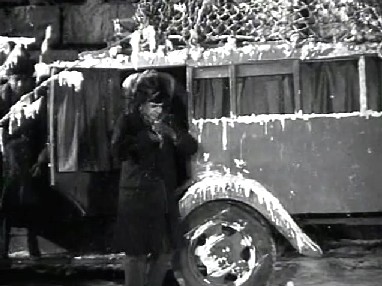
Ah Ching takes his (her?) leave, and the doctors settle down in Yanan. Six months later, the situation’s deteriorated. Drs Mukherjee and Cholkar, both having fallen ill in Yanan, have returned to India. Now Dr Atal is ill too and is about to leave for home. Basu and Dwarka have been given orders to proceed to two separate guerrilla outposts to help attend to the wounded of the guerrilla forces.
Dr Kotnis arrives at the guerrilla outpost he’s been deputed to. This consists of some ridiculously fake-looking caves:
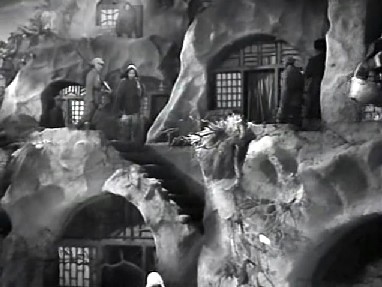
He is introduced to the guerrilla leader, General Fong (Baburao Pendharkar). Fong, we surmise from his hobbling on crutches while a medical orderly tries to bandage his leg, is the never-say-die sort. In post-1962 films, Fong would probably have been the undefeatable, malignant general whom only the hero can conquer. Here, he’s just hearty, vain about his wispy moustache, and fond of Dwarka.
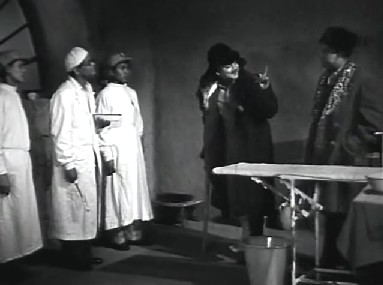
In fact, everybody seems to be fond of the young doctor—including his new assistant, Ah Ching, who’s shown up again like a bad penny. This time, a minor mishap reveals her to be a woman, and Dwarka is fascinated. She tells him her name’s Qinglan, and the sad tale emerges. Qinglan was a medical student at Nanking, where, during the Nanking Massacre, she lost all her family and friends. She’s escaped from Nanking disguised as a man and has been traumatised ever since.
(Why she remains disguised as a man until Dwarka cottons onto her is unexplained. Now that Dwarka knows she’s a woman, she makes no attempt to hide the fact. Ah, Hindi cinema’s mysterious motives).
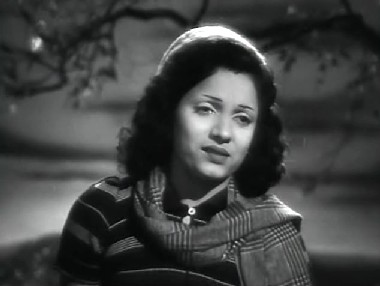
Dwarka sympathises with Qinglan, of course, and before we know it, they’re in love. This consists of long bouts of maniacal laughter at distinctly unfunny stuff, interspersed with an ode to a teapot, on Dwarka’s part:
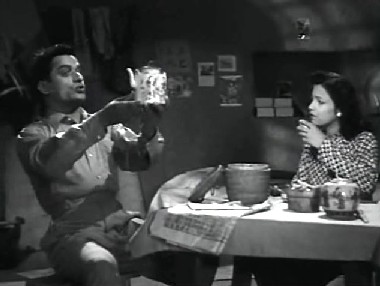
…and, on Qinglan’s part, a Hindi rendition (Main hoon nanhi nayi dulhan) of a song supposedly traditionally sung by Chinese brides. This is a hoot, with Jaishree mincing her way across the floor, hiding behind a bunch of baskets, and simpering like mad:
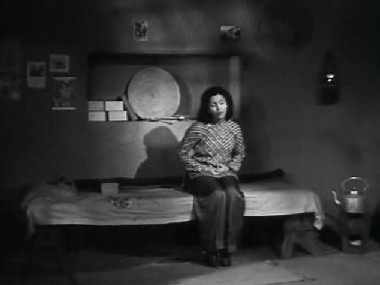
But when he proposes to her, Qinglan refuses Dwarka, telling him she can never marry. He’s understandably miffed. Thank heavens for the timely arrival of Kaka Wong, who puts in a word for Dwarka with General Fong. The general orders Qinglan and Dwarka to marry. Qinglan now seems very happy at the prospect of being wedded to Dwarka, so I can’t see what all the fuss was about in the first place.
Anyway, they get married (and I do think V Shantaram looks kinda cute in that Chinese outfit):
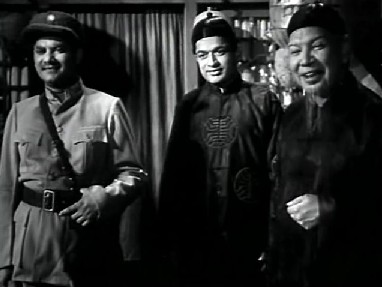
And what a suhaag raat: the Japanese bomb the area that night, and the next day, General Fong announces a pull out. The Japs are on to them and the caves are no longer safe. They’ve got to leave while they still can. So hundreds of men, women and children move out (in an impressive scene, well filmed. Almost certainly in the Western Ghats somewhere, but a believable China). Dwarka and Qinglan go along, attending to the sick and wounded being carried on stretchers.
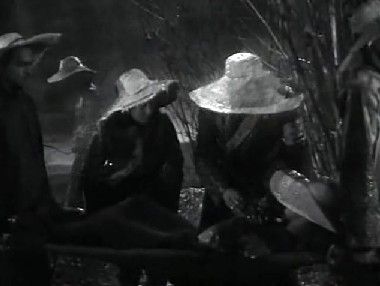
Soon, Dwarka realises that many of his patients are succumbing to a deadly outbreak of pustules. (Dr Kotnis battled a form of plague, though this is never actually named in the film). No matter what medicine he gives them, they’re dying like fleas. Dwarka tells Qinglan he wants to deliberately seed himself with the infection so he can make a test specimen of himself, but she puts her foot down.
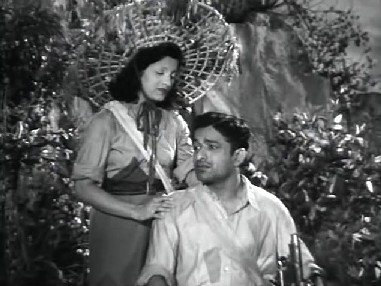
Will Dwarka be able to heal those he’s vowed to serve? Will the Japanese stay away long enough for Fong and Co. to do some singing and dancing (this is, after all, a Hindi film)? Will I be able to think of any of these people as Chinese?
Watch. Really; it’s not as bad as it sounds.
What I liked about this film:
The fact that it grows on you. I’ve come across too many films—Hindi and English—that start off well and deteriorate into gibberish. This one begins slowly and none too promisingly, but after a while, I began to fall under its spell. I suppose I got used to all of its shortcomings, but even otherwise: the pace is better and the scripting (I think) tighter in the second half. The last scene, especially, is memorable and almost surreal. Melodramatic, of course, but still worth a watch.
One of my favourite actresses of the 60’s puts in an appearance. She’s not yet as pretty as she was in later years, but V Shantaram and Jaishree’s real-life daughter Rajshree is cute as a button in her tiny role as Dwarka and Qinglan’s baby son!
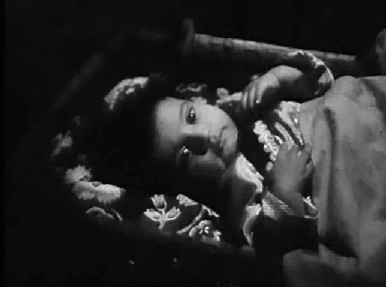
What I didn’t like:
Oh, much. Very much.
As I said, the `Chineseness’ of the film is too unbelievable. Nearly everybody speaks fluent Hindi and signs are in two languages: Chinese and Hindi (yes, I suppose that was the only way to reach out to a largely Hindi-speaking audience, but even then). And the conical hats are oh so not right!
Worst of all, too many of the people just don’t look Chinese. `Papa Ajoba’ (Ram Tipnis), who worked on the makeup, in this delightful interview, reminisces about his experiences while making Dr Kotnis ki Amar Kahani. He talks of how they used, instead of latex or cotton, paint to make Indians look Chinese. Sorry, guys: it didn’t work, especially not for Jaishree.
[The interview, for those who don’t understand Hindi, has an anecdote about Kaka Wong’s beard. The crew included a Chinese lady whom they referred to for costume etc. She said that an old priest—I hadn’t realised that’s what Wong was—would have 36 hairs in his beard. Since such customised beards weren’t available, Tipnis suggested they get the hairs from a horse’s mane. The horse that pulls the cart at the beginning of the film, when Dwarka returns to Sholapur, was used as a source. 36 hairs from its mane went into making Kaka Wong’s beard, which was carefully removed every evening at packup].
The acting. It’s very theatrical and over the top. After a while, you get used to it—and it’s a little better towards the end—but still.
Despite the melodrama, the unconvincing makeup and sets, and the less-than-perfect acting, Dr Kotnis ki Amar Kahani merits watching. If nothing else, it’s an interesting insight into the evolution of Hindi films. The high melodrama and theatrical acting of earlier films was on its way out, and better researched (well, some), more professional film-making was inching its way in. Dr Kotnis ke Amar Kahani itself may seem dated today, but it’s a forerunner for films like Andaz, made a mere 3 years later, but with a freshness that’s survived the test of time.
More on that later.

At least we discovered Dr. Kotnis through this!
Some people/events get overlooked by history, so when DD broadcast this I learnt about Dr. Kotnis (ok, about his existence) and an exhibition entitled Komagatamaru in Chandigarh opened up a whole new chapter of indian history.
There are so many real events that abouind in India, I wonder why we get the same silly stuff hacked over and over again in hindi cinema!
LikeLike
Yes, I remember learning about Dr Kotnis’s existence when DD showed this film; I’d probably never have known about him otherwise: our history books tended to focus only on Indian politics when it came to the mid-20th century.
I’d love to see some good historicals made here: Hindi cinema, as you so rightly say, goes on hacking the same stuff over and over again. Salim-Anarkali and Shahjahan-Mumtaz Mahal are so utterly hackneyed, it’s not funny. And freedom fighters: Bhagat Singh is a particular favourite, isn’t he?
LikeLike
That is exactly what I meant, there are so many heroes/heroines whose real life stories were so gripping. And there are more romances than the Mughals, in fact I seem to remember;) entire dynasties like Guptas or Mauryas that never get a word in!
Did you know about the Koma Gata Maru? That was an eye opener for me as a kid. Wikipedia lists it as an “incident” in the heading, anyone know how to protest or change that?
Meanwhile it was sad also to read about Kotnises real life son but heart-warming to know that ex-Mrs Kotnis was alive and was even included in a state visit to India.
LikeLike
I had heard about Koma Gata Maru, but didn’t know the details. Thanks for jostling my memory about that! Now, why doesn’t somebody make a film about something like that? It involves Indians and it’s an interesting story. No romance, though (which brings me to another grouse I have against most Hindi films: why is romance considered absolutely essential?) Fortunately, that seems to be changing – some of my favourite recent films: A Wednesday, Iqbal and Chak De! didn’t focus on romance at all.
By the way, another (in my opinion!) interesting subject for an Indian film could be the George Edalji case.
LikeLike
Some of these very old films had very interesting subjects. I think then it was more a work of art than ‘commerce’.
I had heard of this film (always in relation to V. shantaram) but never bothered to find out its details.
Now I know. – also about Komagata Maru
Thanks for the review.
LikeLike
I kind of love and hate 40s films at the same time. They are so interesting from a historical perspective, but so hard to watch sometimes…there are some that are fabulous, but they are few and far between…
LikeLike
Thanks for the link to the Edalji case.
Now we seem to be in a wishing world…apparently Deepa Mehta!! of all people has a “big-budget” project for the Koma Gata Maru story, with rumours of Akshay Kumar in the lead (to play Gurdit Singh Jawanda)!
Will it be a serious film, or will it become a bollywood masala-romance?
Another page seemed to suggest Big B was in the cast.
Link to KGM story
http://www.komagatamaru.ca/history.asp
LikeLike
pacifist: You’re welcome, and thank you for reading! I guess in all times and all ages, though, there are people for whom their work is a passion – art for the sake of art – and there are people for whom it is commercial. Sometimes one is lucky enough to come across films that are truly made for art!
memsaab: Ah, yes: we know that, don’t we? From bitter experience! Poor you – a floppy-haired Raj Kapoor + lunatic screenplays don’t add up to one of the better 40’s films…
bawa: I didn’t know about that, thanks so much. I do hope it works out: Deepa Mehta’s so good, and if she can manage to pull off a seriously good, non-masala film, that’ll be awesome. Frankly, I think Akshay Kumar has potential, it’s just that it’s barely ever tapped. Sad.
LikeLike
It takes patience to watch such movies. Rajshree’s debut ! wow ! I loved her too.
LikeLike
This one wasn’t bad, actually. If you could tolerate the very theatrical acting (which was particularly bad in the first few minutes of the film) and overlook the lack of authenticity as far as the Chinese were concerned, it wasn’t bad – and it’s an interesting insight into the history of Hindi cinema. Definitely worth watching at least once!
And yes, I love Rajshree: she’s so lovely. I wish she’d done more films.
LikeLike
LOL! Yes. I take my words back. I had quite forgotten the review I read over at memsaab’s, of Dil Ki Rani.
LikeLike
I think from what memsaab wrote about Dil ki Rani, Dr Kotnis… was way better! ;-) At least this had a coherent storyline, it was fairly interesting, and they had made an attempt (no matter that it wasn’t totally successful) to evoke China.
LikeLike
O I had to see this movie as a child of 9 yrs as it was a historical movie and i if I remember it right it was quite entertaining and I think I felt quite patriotic ater watching it! ;-) :-0
Shantaram looks quite handsome though, doesn’t he?
I somehow never liked Rajashree, she had such a dry face!
LikeLike
Yes, doesn’t Shantaram look quite handsome? I was pleasantly surprised; the last time I saw a film of his, it was Do Aankhen Baarah Haath and he’s nowhere close to handsome in that!
Oh, I like Rajshree: I think she’s cute. I wish she’d done some more fun films like Jaanwar and not the weepy types like Geet Gaaya Pattharon Ne or idiotic ones like Shehnai and Around the World.
LikeLike
Shantaram evidently produced this in both Hindi and English versions. Whether the English version was ever actually released, I don’t know, but it wound up as the basis for a 1950’s exploitation film called “Nightmare in Red China”. Much was apparently cut, but the basic Dr. Kotnis story is retained, going to China, the romance, and his trying the injection on himself. This is interspersed with footage from an actual documentary on China, and “atrocity” scenes evidently shot by the American producer, depicting soldiers rading a temple, attacking women etc. The Chinese bride song was left in (with english lyrics). How this all came about would be interesting to know. I have the film on an old videotape .
LikeLike
part of this film is on you tube now.
its title was also the song of buddha
there is a chapter on this in the biography – Shantarama
– Dr. Suresh Chandvankar
chandvankar.suresh@gmail.com
LikeLike
no. song of buddha was the official english version which shantaram took to usa along with shakuntala. nightmare in red china as ken says is an exploitation flick. look up imdb and the film credits shantaram with “principal footage”. the other credited director was also an editor and this is his only direction credit. which means he interspersed shots from the documentary with the actual film to come up with something else altogether.
LikeLike
Wow, that’s interesting! I’d never heard of this, but will certainly look out for it – though I doubt it’ll be available on DVD or VCD :-(
Yes, I read that the film was also made in English as The Immortal Story of Dr Kotnis. Have never come across it, though…
LikeLike
This film is the only reference, I’ve ever come across, to Dr. Kotnis! V. Shantaram certainly tackled unusual and interesting subjects in his films but I found most of them quite hard to watch – they’re so clearly make-believe that its hard to engage with them or feel for their characters. I’ve been reading Balraj Sahni’s memoirs (unearthed by Richard) and was amazed to find that Shantaram’s films were considered very realistic, back then! Guess Shantaram’s contemporaries were a LOT more theatrical.
And I join in the Rajshree love, too! She was lovely.
LikeLike
PS: Thanks for the Edalji link. I’d never heard of that case! And I cant help but feel happy that Connan Doyle was a right ‘un! :-D
LikeLike
Shantaram made realistic films? Oh, lord – I don’t think I want to see any non-Shantaram films (well, memsaab’s review of Dil ki Rani has put me off that one at least!). In any case, V Shantaram’s films don’t generally appeal to me either.
Yes, my sister first told me about the Edalji story. I had no idea, but well done, Conan Doyle! :-)
LikeLike
Thank you for the Edalji link!
Very interesting!
Well, Shantaram did make good films in the beginning of his career till he got besotted with Sandhya and her ‘dancing’. They are as it was quite common for that age very theatrical. But many of these movies had good social messages. He made a nice film (Padosi) on Hindu-Muslim friendship, where he interestingly cast the muslim character with a hindu and vice-versa. Other notable films were Dahej, Duniya na mane (about young girls being forced to marry older men). An interesting film was also Amrit manthan, where one never saw Chandra Mohan, but just his eyes. This was to highlight the fact about his hypnotic appeal on the masses. He plays a fanatic priest. A good movie against religious fundamentalism.
LikeLike
bollyviewer: I lost my copy of Balraj Sahni’s autobiography! :-(
LikeLike
Thank you for those recommendations – I’d not even heard of them before! (Except Duniya na Maane, which I think I saw on Doordarshan when I was a kid). Will try and look out for them. And will try to overlook the theatrical style of acting. ;-)
Incidentally, I downloaded the Balraj Sahni biography too, but it was a corrupted file. Will try again.
LikeLike
Since a boy, I wanted to see this film.I was a school boy when this film was screened in my small town and my parents were not allowing me to go to the film. But i have heard all elders speaking good of this film and other films by V. Shantharam. In my later life, I have read much about films including this film.This article gave me some glimpses of the film which I otherwise would not have gotten.
One point is missing here. The original author of the biography of Dr. Kotnis was another Mumbai man-Vasanth Sathe, who was a voracious reader and also a n active politician9 He later became a union minister in 1970s.The tittle of that book is ‘…And one did not come back’.H. A. Abbas, another author and film directer,gave that book to V. Shantharam, who was known for his good taste ion film making( see-‘I am not an island’-Autobiography of K.A. Abbas).It clicked , and V.Shantharam made that movie.
People with such good taste are now invisible in In dian film field!
Thanks a lot for this article.
LikeLike
Just to keep the record straight. Vasant P Sathe the collaborator with K A Abbas of several Raj Kapoor screenplays (Shree 420, Awara etc) and of Dr Kotnis is not the same Vasant P Sathe who became a Union Minister of I&B. The first V P Sathe was my guru and owned a PR agency called Bombay Publicity Services in Bombay. The Minister V P Sathe I met when I was News Editor of Screen. The first was a card-carrying member of the Communist Party of India and the Minister was a Congressman till his dying days.
Sathe did not write And One Did Not Come Back. It was Abbas who wrote the novelette for the Sound magazine (1944) and later was published as a book. Abbas and Sathe were friends and so Sathe took Abbas and the book to Shantaram who, he knew, was looking for a patriotic story. Those were the days of the limited raw stock due to the war and hence the Government was giving raw permits only for nation building stories. Dr Kotnis was granted raw stock under that permit.
LikeLike
You’re most welcome! Thank you also for that bit of information. In fact, Dr Kotnis ki Amar Kahani was made both in Hindi as well as English, and as far as I know, the alternate name of the film in English was And One Did Not Come Back.
At any rate, this is a good film. True, it is dated, and the ‘Chineseness’ of the entire scenario isn’t very convincing, but still a laudable effort. And of course, a landmark in Hindi cinema.
LikeLike
Pingback: Dr. Kotnis Ki Amar Kahani (1946) « Dances on the Footpath
Pingback: Zindagi zindagi zindagi koi sapna nahin zindagi « atul's bollywood song a day- with full lyrics